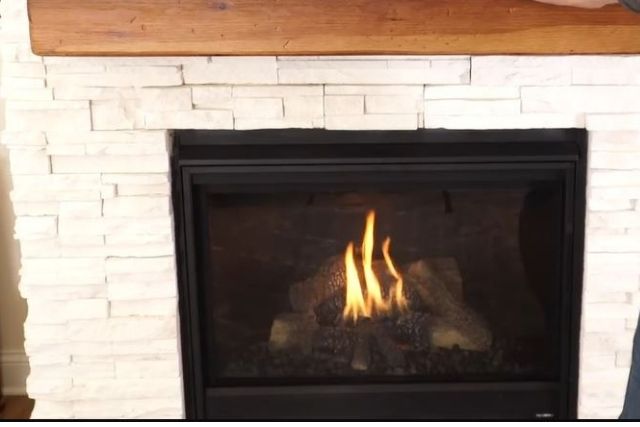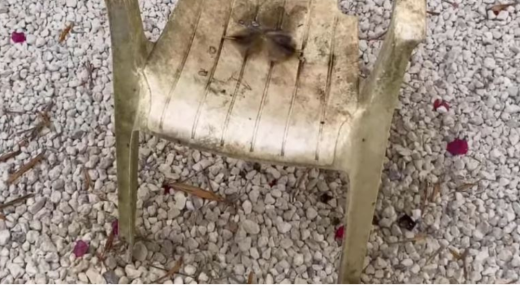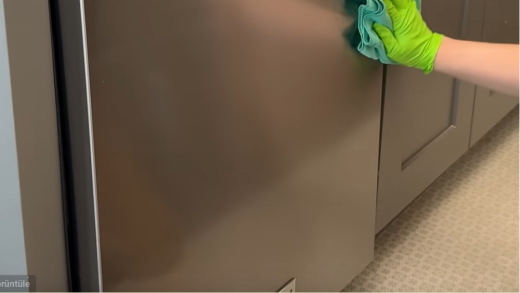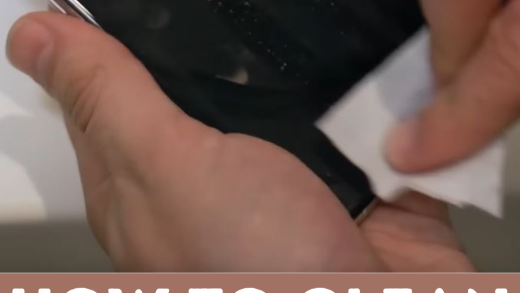Clean a gas fireplace to help it burn efficiently and lower the risk of carbon monoxide entering your home. A gas fireplace will get dirty when a chimney blockage, burners, or gas logs become sooty over time. A blockage can cause poor ventilation, making it difficult for carbon monoxide fumes to vent outside.

Although gas fireplaces look beautiful, like authentic wood-burning fireplaces, they do not use real logs or leave behind ashes. But you must still regularly clean gas fireplaces, including ventless types. Cleaning is critical if the fireplace is used continuously during the chilly months.
Warning
If your gas fireplace has a glass enclosure, ensure it is adequately secured. Also, check the flame ignites to a bluish color, lighting instantly, without delay. The exhaust vent should also be clear of obstructions.
How Often to Clean a Gas Fireplace
Even though gas fireplaces do not burn wood or make smoke, cleaning a gas fireplace monthly is essential, even when it is not being used. Regular cleaning will prevent dust and dirt from harming mechanisms and allow you to inspect the system for damage.
If your gas fireplace has a glass enclosure, clean it with a commercial fireplace glass cleaner or a non-ammonia-based glass cleaner to remove the dust or buildup. To save a few dollars, a homemade vinegar solution should work well.
Tip
When doing regular maintenance on your gas fireplace, also take an extra minute to check your carbon monoxide detector batteries. Most detectors have a test button for a quick battery check.
What You’ll Need
Equipment / Tools
Hand broom or unused paintbrush
Vacuum with hose attachment
Cheesecloth or nylon net
Spray bottle (optional)
Materials
Fireplace glass cleaner or non-ammonia glass cleaner
Warm water
Cleaning rags
Instructions
How to Clean a Gas Fireplace
Turn Off the Gas
Before you do anything, turn off the gas. Completely turn off the gas valve on the wall next to the fireplace.
Check that the pilot light is out and wait a few minutes before beginning to work. This precaution will allow all of the gas to leave the piping safely.
If the fireplace has been used recently, ensure all components are completely cool before cleaning.
Disassemble the Fireplace
Carefully disassemble the logs and remove the burner unit. This step will vary depending on the design of your fireplace. If you have glass doors, a metal screen, or a mesh curtain, remove them for easier cleaning.
If possible, take the components outside for cleaning to prevent the spreading of dust and soot in your living area.
Tip
When it is time to reassemble the gas fireplace components, they must return to the same configuration. If you’re not sure if you’ll remember how to do it, take several pictures of each step as you do it.
Brush and Inspect
Use a hand broom or soft paintbrush to remove dust and dirt on each log or decorative component. Never spray cleaners or water onto gas fireplace components.
While cleaning, inspect each log or piece for any cracks, holes, or excessive burn marks. Brush away debris from the burner unit and inspect each vent hole for any build-up that could clog the gas flow.
Tip
Check the outside vent monthly for blockages from leaves or animal nests if your gas fireplace vents outside.
Vacuum Away Dust and Cobwebs
If you use lava rocks or glass stones, they can accumulate dust. Use a hose attachment vacuum to clean each rock’s side. Once the rocks are clean, vacuum all the corners of the fireplace box to capture dust, cobwebs, and insects.
Use an old cloth to wipe down the pilot light and gas line components.
Polish Glass or Metal
Many gas fireplaces have glass doors that can become cloudy with particulates from combustion. Regular cleaning will help prevent the glass from becoming permanently etched.
You can find a fireplace glass cleaner at your local hardware store or make a cleaning spray with a vinegar solution.
Spray the cleaning solution and allow it to work for several minutes before using a soft cloth to remove the debris and film. If you have a metal screen or mesh curtain, use the vacuum upholstery brush to clean both sides to remove dust.
Wipe the edges with a water-moistened cloth for glass and metal enclosures to remove dust. Inspect the rubber gaskets on glass doors for any deterioration or cracking. If you see any damage, replace the gasket.
Wipe Down the Mantel and Hearth
Clean any soot or dust from the mantel and hearth. Depending on the type of surface, dust with a soft cloth and carefully follow soot removal guidelines.
Reassemble the Gas Fireplace
Once clean, reassemble the burner, logs, and stones, and replace the outer glass or screens. Now, you can turn the gas valve back on.
Homemade Glass Cleaner for Glass Enclosure
A good ammonia-free glass cleaner, such as a white vinegar solution, is your best bet for cleaning the glass partition of your gas fireplace. Use equal parts water to equal parts vinegar.
Refrain from using Windex and commercial glass cleaners that contain ammonia. Do not add soap or detergent. Soap and ammonia residues do not react well with heat, making the glass look bad.
Tips to Keep Gas Fireplaces Clean Longer
Your best tip for keeping a fireplace clean is simple: clean it regularly. If it’s part of your regular house cleaning routine and you miss a month, especially during the months it’s off; it should keep up its appearance.
Another tip for keeping your gas fireplace clean longer is to pay close attention to the color of the pilot flame. It should look like a blue flame with a tiny tip of yellow. If it has changed color or a great deal of soot is collecting on the fireplace components, your gas company may need to inspect the gas line.
Warning
Immediately turn off the gas line if you smell a gassy, rotten egg smell, and ventilate the room. Call 911 or your gas company.
When to Call a Professional
If the fireplace has not been used for several years or you buy a house with a gas fireplace installed, call a qualified technician for an evaluation before using it. To be safe, get an annual inspection by a professional natural gas technician to check wiring and gaskets, in addition to doing your routine cleaning.
A professional will inspect the glass enclosure, the sealing gaskets, the inside and outside of the firebox, the outside vents or chimney (if it vents through the chimney), the carbon monoxide detector, and the burner.
If there is a problem with the gas line, a plumber can fix it at an hourly cost of $50 to $200. An annual inspection can cost from $70 to $200, depending on your location and how your system is set up.
FAQ
Do gas fireplaces need to be cleaned?
Gas fireplaces still need to be cleaned. Propane and natural gas are clean burning gas fuels, so they don’t produce ashes and soot, but they can still develop buildup that needs cleaning.
What is the best cleaner for a gas fireplace?
Never use any chemicals inside the fireplace since the gas and heat may negatively interact with free-flowing gas. Instead, clean the interior with a water-moistened cloth and vacuum away dust. Add a little dish soap to the cloth if you need a stronger cleaner on the bricks, but refrain from using soap on glass or metal.
Can you use Windex on the inside of a gas fireplace?
Never use Windex or other ammonia-based cleaners on hot glass surfaces. Ammonia reacts negatively with heat. It can leave a permanent film on the glass when heated.
Why is my gas fireplace burning so dirty?
Soot buildup can occur on a gas fireplace if a fireplace gets dusty and dirty and cleaning is neglected. Ports on the gas burner can get clogged and need cleaning. Another cause can be an obstructed air vent or a ceramic log that shifts and interferes with the flame. Clean the fireplace, and if the problem persists, contact an expert to ensure it’s not a problem with the gas regulator or the age of the unit reaching its upper limit.


